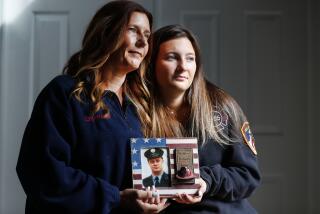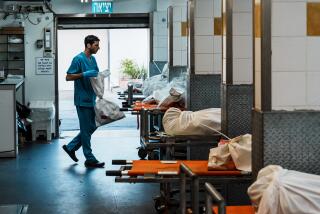Experts Have Tough Task of Identifying Victims
When the terrorists struck, the phone on Lt. Fred Corral’s desk at the Los Angeles County coroner’s office began to ring.
Corral, who heads one of 10 national Disaster Mortuary Operational Response Teams, was told to put his unit on alert. Some of the region’s top forensic dentists were also called up. Army reservists were told to pack their bags, and specialized units--such as those including search and rescue dogs--were flown East to assist in the search for what are now estimated to be 6,300 bodies trapped in the rubble of the World Trade Center.
As dozens of firefighters return from the overwhelming rescue operation, many in Corral’s unit are just getting started.
They are the death squad, a volunteer team of 1,000 scientists, forensic experts and funeral specialists who descend on the scenes of the nation’s worst tragedies to complete a horrible--though essential--task: putting names to the faceless dead, regardless of how little of the body remains.
“We are the people you never want to hear about,” Corral said. “No one wants to deal with death, especially this kind of death.”
Corral, who runs Team 9, which covers California, Arizona, Nevada and Hawaii, said 40 specialists from his unit are assisting experts in New York, the Washington area and Pennsylvania in the gruesome task of matching bits of clothing, tattoos, teeth and fingerprints to a name.
In a program run by the federal Department of Health and Human Services, members of these teams give up their vacation time--and often take time off from work without pay--to locate and identify the bodies, and prepare them for burial.
At the World Trade Center, the job could take months.
“It’s a long process,” Corral said. “They have been finding body pieces: arms, hands, limbs. In some cases the remains are commingled, and in others they have been cremated and may never be identified.”
Orange-and-white hazardous waste buckets dot the mountain of wreckage at the disaster site. Rescue workers, many from mortuary teams, wade through the rubble, steadily filling the buckets with any trace of a survivor.
Often, what remains is minimal.
The buckets are then taken to a temporary morgue in the lobby of a nearby office building on the Hudson River.
There, workers in hospital scrubs, asbestos suits, booties and masks package the containers in body bags and send them on to be tested. Dozens of medical and mortuary workers cram into the New York County coroner’s lab, and try everything from standard tricks--fingerprints, dental records--to more exotic techniques--DNA tests--to match the remains to a missing person.
Among those who flew to New York to assist in the identification of victims were Gerald L. Vale, professor of forensic dentistry, and Joseph Anselmo, associate professor of clinical dentistry, both from the USC School of Dentistry.
Michael Bowers, a Ventura County dentist and forensics expert, plans to fly to New York next week to assist in the laborious process of identifying victims. For 16 years, he has identified murder and accident victims, including those killed when Alaska Airlines Flight 261 crashed off Point Mugu last year, killing all 88 aboard.
Bowers, 52, said he plans to spend a week to 10 days in New York helping teams of investigators identify victims through dental X-rays, cavities, crowns and the shape of teeth.
“I’m not looking forward to it,” said Bowers, who has taught forensic dentistry at the Armed Forces Institute of Pathology in Washington and the University of Texas, San Antonio. “The families’ trauma in this case will be extended. It may take one or two years to identify everyone.”
Rick McAnally, assistant chief deputy coroner for the Orange County Sheriff’s Department, was flown to New York early Thursday morning to aid in the recovery and identification of victims at the World Trade Center.
“It may seem overwhelming to some, but what he’s doing is basically . . . what our job is here on a daily basis,” said Bruce Lyle, the supervising deputy coroner. “He’ll be doing all the same things, but just on a larger scale.”
About half a dozen Orange County sheriff’s employees have been called up as well, according to department spokesman Jim Amormino.
*
Times staff writers Monte Morin, Karima A. Haynes, David Kelly and Tina Dirmann contributed to this report.
More to Read
Sign up for Essential California
The most important California stories and recommendations in your inbox every morning.
You may occasionally receive promotional content from the Los Angeles Times.










